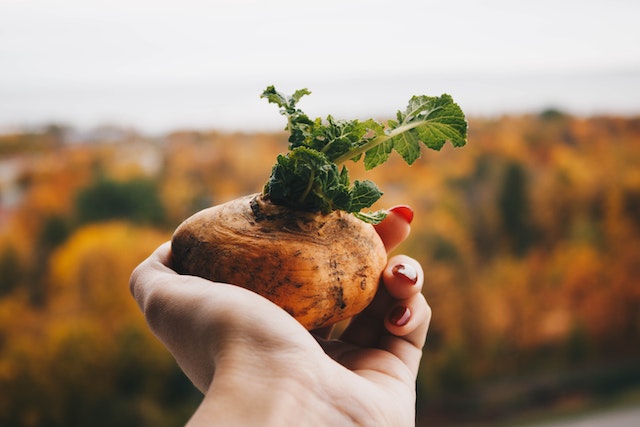Are potato leaves edible? This is a commonly asked question among those curious about the full potential of this versatile crop. The answer is yes, potato leaves can indeed be consumed, offering a surprising array of culinary possibilities.
While often overlooked, these leafy greens can add a unique twist to your meals, imparting a subtle earthy flavor and a tender texture. Whether you’re a culinary adventurer or simply looking to diversify your plate, exploring the world of potato leaves is an exciting endeavor.
In this article, we will delve into the topic of potato leaves, their edibility, and how you can incorporate them into your cooking repertoire. So, let’s embark on this green culinary journey together!
Are Potato Leaves Edible?
Potatoes are a staple food in many households around the world. They are versatile, delicious, and can be prepared in countless ways. But what about the leaves of the potato plant? Are they edible, too?
In this article, we will explore whether potato leaves are safe to eat, their nutritional value, and how they can be incorporated into your culinary repertoire.
1. The Safety of Eating Potato Leaves
A Brief Note on Toxicity
Potato plants belong to the Solanaceae family, which includes other nightshade vegetables like tomatoes and eggplants. While the tubers of the potato plant are safe for consumption, other parts of the plant, such as the stems, flowers, and leaves, contain a toxic compound called solanine.
Understanding Solanine
Solanine acts as a natural defense mechanism for the potato plant, deterring animals and insects from consuming it. Ingesting large quantities of solanine can cause digestive discomfort, nausea, and even more severe symptoms in some cases.
However, solanine is concentrated in higher amounts in the green parts of the potato plant, such as the leaves.
Proper Preparation and Cooking
To safely consume potato leaves, it is crucial to eliminate or reduce the solanine content through proper preparation and cooking methods. Here are some steps to follow:
- Choose young and tender leaves, as they contain lower levels of solanine compared to mature leaves.
- Thoroughly wash the leaves to remove any dirt or residue.
- Blanch the leaves in boiling water for a few minutes to further reduce solanine levels.
- Refresh the leaves in cold water and pat them dry.
- Use the blanched leaves in recipes that require cooking, as heat further breaks down solanine.
2. Nutritional Value of Potato Leaves
A Rich Source of Vitamins and Minerals
Potato leaves are highly nutritious and offer an array of vitamins and minerals. Here are some key nutrients found in potato leaves:
- Vitamin C: Potato leaves are rich in vitamin C, which is essential for a healthy immune system and collagen production.
- Vitamin K: These leaves are a great source of vitamin K, important for blood clotting and bone health.
- Vitamin A: Potato leaves contain vitamin A in the form of beta-carotene, which supports eye health and immune function.
- Iron: They are also a good source of iron, a mineral necessary for oxygen transport and energy production.
- Calcium: Potato leaves provide calcium, which is vital for strong bones and teeth.
Antioxidant Properties
Potato leaves are packed with antioxidants that help protect the body against oxidative stress and inflammation.
These antioxidants, such as chlorogenic acid and quercetin, have been shown to have potential health benefits, including reducing the risk of chronic diseases.
3. Culinary Uses and Recipes
Traditional Dishes
In some cultures, potato leaves have long been included in traditional dishes. For example:
- In parts of Africa, potato leaves are used in stews, soups, and sauces, adding a unique flavor and nutritional boost.
- In South America, potato leaves are sometimes added to empanadas or cooked as a filling for savory pastries.
Salads and Wraps
Potato leaves can also be used in salads or as a wrap for other ingredients. Their slightly tangy flavor adds freshness to the dish. Try these ideas:
- Create a vibrant salad by combining blanched potato leaves with cherry tomatoes, cucumbers, and a light vinaigrette.
- Wrap grilled chicken, avocado, and salsa in blanched potato leaves for a nutritious and low-carb alternative to tortillas.
Stir-Fries and Sauteed Dishes
Potato leaves can be a delightful addition to stir-fries and sautéed dishes. They add a unique texture and taste. Consider these options:
- Sauté potato leaves with garlic, olive oil, and a squeeze of lemon juice for a simple and flavorful side dish.
- Include potato leaves in your favorite stir-fry recipe alongside other vegetables and protein.
While potato leaves are generally safe to eat when properly prepared, it is crucial to be cautious due to the presence of solanine.
To enjoy potato leaves, ensure you follow the proper preparation steps, such as blanching and cooking, to reduce solanine levels.
By doing so, you can unlock the nutritional benefits of potato leaves and incorporate them into a variety of delicious dishes. So, don’t let those vibrant green leaves go to waste – give them a try in your next culinary adventure!
Frequently Asked Questions (FAQs)
Potato leaves are not typically consumed by humans. While potato plants produce edible tubers, their leaves contain toxic substances called glycoalkaloids, such as solanine and chaconine, which can be harmful if ingested in large amounts.
Potato leaves do contain some nutrients, including small amounts of vitamins A and C, and minerals like iron and calcium.
However, the concentrations of these nutrients are relatively low compared to other leafy greens that are commonly consumed, such as spinach or kale.
Some animals, such as cows, can safely consume potato leaves as part of their diet.
However, it’s important to note that even for animals, excessive consumption of potato leaves can lead to digestive issues due to the presence of glycoalkaloids.
If you accidentally consume a small amount of potato leaves, it is unlikely to cause significant harm.
However, if you experience any adverse symptoms such as nausea, vomiting, or abdominal pain, it’s advisable to seek medical attention immediately.
In general, potato leaves are not commonly used for culinary purposes due to their potential toxicity. It is safer and more common to use other leafy greens that are known to be safe for consumption.
While potato leaves are not commonly eaten or used in cooking, they can still serve a purpose.
Some people use potato leaves for composting or as mulch in their gardens, as they can help enrich the soil and promote healthy plant growth.
To ensure the safety of your potato plants, it is important to practice proper cultivation techniques. This includes planting certified disease-free potato seeds, providing adequate sunlight and water, and regularly inspecting the plants for signs of disease or pests.
Yes, the tubers of the potato plant are the edible part that is commonly consumed. However, it is important to note that only healthy, properly cooked potatoes should be eaten, as eating raw or spoiled potatoes can also be harmful.
Final Thoughts
Potato leaves are indeed edible. While they may not be as commonly consumed as the tubers themselves, potato leaves can be a nutritious addition to your diet. Packed with vitamins and minerals, they offer a range of health benefits. However, it is important to note that not all potato leaves are safe to eat.
Certain varieties, including wild and green ones, contain toxic compounds that can be harmful if ingested. Therefore, it is crucial to ensure that you are consuming the correct type of potato leaves from a reputable source.
So, if you are curious about incorporating potato leaves into your meals, take precautionary measures and enjoy their potential benefits.
Auto Amazon Links: No products found.
Perfect Plants Christmas Tree Saver 8oz. | Easy Use Xmas Tree Preserver Food | Have Healthy Green Christmas Trees All Holiday Season
$7.99 (as of December 25, 2025 06:40 GMT +00:00 - More info- Product prices and availability are accurate as of the date/time indicated and are subject to change. Any price and availability information displayed on [relevant Amazon Site(s), as applicable] at the time of purchase will apply to the purchase of this product.
FirEver Pure Christmas Tree Food | Preserver Additive & Season Extender for Live Xmas Trees | Keep It Green, Reduce Needle-Drop | Miracle Freshness (8 oz)
$9.16 (as of December 25, 2025 06:40 GMT +00:00 - More info- Product prices and availability are accurate as of the date/time indicated and are subject to change. Any price and availability information displayed on [relevant Amazon Site(s), as applicable] at the time of purchase will apply to the purchase of this product.
Wilt-Pruf® Christmas Tree/Cutting Preserver Spray |Preserves Christmas Trees, Wreaths, Garlands, Cuttings and Carved Pumpkins | Reduces Needle Drop | Keeps Cut Trees Fresh Longer | Natural (32 oz)
$21.99 (as of December 25, 2025 06:40 GMT +00:00 - More info- Product prices and availability are accurate as of the date/time indicated and are subject to change. Any price and availability information displayed on [relevant Amazon Site(s), as applicable] at the time of purchase will apply to the purchase of this product.
Transmission Funnel - 3'' Wide 23'' Long Funnel with Hose – Flexible, Reusable, No Leak Design Featuring Elastic Long Hose | Long Funnel for Oil, Gas, Coolant, Automotive and Garage Applications
$7.95 (as of December 25, 2025 06:40 GMT +00:00 - More info- Product prices and availability are accurate as of the date/time indicated and are subject to change. Any price and availability information displayed on [relevant Amazon Site(s), as applicable] at the time of purchase will apply to the purchase of this product.
Rocky Mountain Goods Christmas Tree Food - 8 oz Tree Preservative - Reduce Needle Drop - Greener Scent - Fir, Pine, Spruce Trees - Extend Tree Life
$9.95 (as of December 25, 2025 06:40 GMT +00:00 - More info- Product prices and availability are accurate as of the date/time indicated and are subject to change. Any price and availability information displayed on [relevant Amazon Site(s), as applicable] at the time of purchase will apply to the purchase of this product.
Muddy Mat® | Super Absorbent Door Mat Indoor, Microfiber Quick Dry Chenille Entryway Rug, Non-Slip Front Door Mat, Indoor Mats for Entryway, Machine Washable Pet Rug, Grey 30"x19"
$24.95 (as of December 25, 2025 12:41 GMT +00:00 - More info- Product prices and availability are accurate as of the date/time indicated and are subject to change. Any price and availability information displayed on [relevant Amazon Site(s), as applicable] at the time of purchase will apply to the purchase of this product.
OLANLY Dog Door Mat for Muddy Paws 30x20, Absorbs Moisture and Dirt, Absorbent Non-Slip Washable Doormat, Quick Dry Chenille Mud Mat for Dogs, Entry Indoor Entryway Carpet for Inside Floor, Grey
$9.99 (as of December 25, 2025 12:41 GMT +00:00 - More info- Product prices and availability are accurate as of the date/time indicated and are subject to change. Any price and availability information displayed on [relevant Amazon Site(s), as applicable] at the time of purchase will apply to the purchase of this product.
Zevo Flying Insect Trap Official Refill Cartridges - Fits Both Zevo Trap & MAX Indoor Fly Trap - Authentic Trap+Lock Technology to Catch Gnats, House & Fruit Flys (4 Official Refill Cartridges)
$14.97 (as of December 25, 2025 12:41 GMT +00:00 - More info- Product prices and availability are accurate as of the date/time indicated and are subject to change. Any price and availability information displayed on [relevant Amazon Site(s), as applicable] at the time of purchase will apply to the purchase of this product.
TERRO Ant Killer Bait Stations T300B - Liquid Bait to Eliminate Ants - Bait System - 12 Count Stations for Effective Indoor Ant Control
$10.88 (as of December 25, 2025 12:41 GMT +00:00 - More info- Product prices and availability are accurate as of the date/time indicated and are subject to change. Any price and availability information displayed on [relevant Amazon Site(s), as applicable] at the time of purchase will apply to the purchase of this product.
ThermoPro TP50 Digital Hygrometer Indoor Thermometer Room Thermometer and Humidity Gauge with Temperature Humidity Monitor
$11.99 (as of December 25, 2025 12:41 GMT +00:00 - More info- Product prices and availability are accurate as of the date/time indicated and are subject to change. Any price and availability information displayed on [relevant Amazon Site(s), as applicable] at the time of purchase will apply to the purchase of this product.











